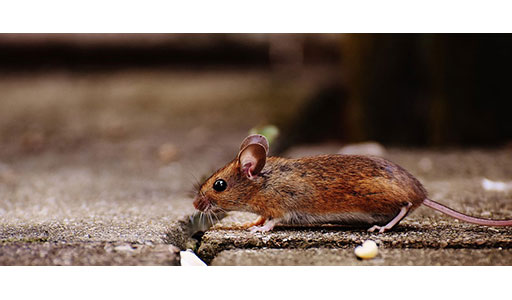Mouse Pest Control
Do you need to get rid of mice? We can help!

Mouse Removal Strategies
Mouse Problem

Signs a Mouse is on Your Property
You are more likely to notice evidence of mice infestation than see an actual mouse. Mice are nocturnal and avoid human activity. They tend to invade in wall cavities, attics, basements, or behind cabinets.
What does a mouse sound like?
Mice make high-pitched squeaks and are notorious for making scratching and scuffling noises. Mice poop is one of the most obvious signs of an infestation. Mice droppings measure a quarter of an inch. They poop near food and along pathways the rodents consistently use.

Dangers of Mouse Infestation
A single mouse can leave behind 50 to 60 droppings in one night. Their excrement and general presence contributes to the spread of several diseases like salmonellosis, meningitis, ringworm, leptospirosis, and dermatitis. The pests also contaminate whole containers of food and gnaw on wiring, which puts households at risk of electrical fire.
Humane Mouse Removal & Control Strategies

Entry into property
Residential lawns and manmade buildings offer mice everything they need in terms of food and shelter. House mice are able to enter homes through openings in buildings as small as a quarter of an inch in diameter. They get inside via cracks in foundations, siding, floors, and walls. Gaps around windows and doors are often large enough to provide mice entrance, as well. The pests also force their way inside homes from roofs. They reach those heights by way of trees or utility lines and enter buildings through vents or chimneys.

Trapping & Removal
Unfortunately, mice populations are difficult to control because of the pest’s agility and adaptability. Though many traps are commercially available to homeowners, individuals are better off contacting pest control professionals. Experts understand mouse behavior and effectively remove the pests from homes, as well as sanitize areas affected by infestations. If you know or suspect your home may be in need of mice control or mice removal, don’t wait! Call Trutech, we have a staff of Mouse Control Specialists who are fully licensed and insured. We are experts at mouse control, mouse removal and prevention of rodents in both residential and commercial areas.

Prevention & Exclusion
Regular sanitation goes a long way in reducing the possibility of attracting mice. Homeowners should wipe up spills as soon as they happen and vacuum often. Purchasing tightly fitted lids for garbage cans and rodent-proof containers for foodstuffs limits food availability. As house mice can squeeze through openings as tiny as a quarter of an inch in diameter, individuals must plug holes with cooper mesh or steel wool and use caulk around windows and doors. Additionally, homeowners should maintain yards by picking up debris and keeping grass trimmed short.
Mice in House
Where do mice hide during the day?
Mice enter buildings in search of food sources, to escape predation, and to breed. Once inside, they enjoy making nests in secluded areas with sufficient warmth. For this reason, mice often take up residence inside the walls of buildings. The pests gain access to wall cavities via piping, air ducts, and external holes in structures. Since they are small creatures, mice are capable of slipping through holes less than a quarter of an inch in diameter. Since their populations grow rapidly once a nest is established, it’s important that homeowners remain alert for signs of mice in walls.

SIGNS OF MICE IN THE WALLS OF A HOME
Sounds and smells are helpful in determining if there are mice in the walls. Scurrying and scratching sounds will be common during the night. Homeowners may also hear squeaking coming from wall cavities. As a single mouse produces 50 to 75 droppings a day, excrement will quickly accumulate given an infestation. It won’t be long before the smell pervades the building. Additionally, mice give off a characteristic musky odor that helps with the detection of mice in walls. Finally, as their fur is greasy and dirty, mice often leave marks on wall exteriors as they scamper alongside floorboards.
Mice in Attic
Cold autumn and winter weather drives house mice to seek shelter indoors, where they often wind up in the secluded safety of the attic. Mice have tiny but strong claws on each of their digits that make climbing easy. As such, the pests are able to access attics by climbing trees and entering from the roofs of homes or by finding their way up from inside buildings with the aid of the piping and ductwork. Many attics are small and have limited access points big enough for humans, which makes it easy for tiny mice to enter and difficult for homeowners to remove them.

SIGNS OF MICE IN THE ATTIC
MOUSE SOUNDS IN THE ATTIC Without entering attics to conduct periodic inspections, homeowners may not detect mouse infestations until it is too late. Mice breed rapidly and can cause widespread structural damage, as well as contaminate houses with feces and urine. By paying attention to the sounds and smells around the house, in addition to keeping an eye open for adult mice scampering around, residents can identify mice in the attic without having to climb up for a visual inspection. Hearing scratching, scuttling, or squeaking sounds coming from the attic strongly indicates the presence of as infestation. These sounds will be more prevalent at night when the animals are most active. Additionally, the pungent smell of feces and urine will pervade the top level of a house if mice are living in the attic.
Mouse in Air Ducts:
We recently discovered a mouse in our air duct this evening. We have placed a trap but are not sure if there is a larger problem at hand. We were hoping for someone to come help remedy the situation if possible.
-Alexandria, VA
ANSWER:
Mice in air ducts is often an indicator of a larger problem. One misconception we often come across is when homeowners set their own traps, catch a mouse or two, and think the problem is resolved. Unfortunately, this is usually far from the truth. Mice are often neophobic and can be cautious of traps, especially after a few have been caught.
Being at the bottom of the food chain also requires mice to breed at a very high rate. One female is able to produce an average litter of 5-8 young every 20-25 days. She is actually able to become pregnant again just hours after giving birth to a litter.
Given that mice become mature at around 6 weeks and can then start having litters of their own, you can see how this problem could get out of hand very quickly.
To keep mice out of air ducts, Trutech technicians use knowledge from their educational background and extensive training to determine the best areas to concentrate treatment of your home.
This begins with a complete “top to bottom, inside and out” inspection of the home. We want to know where the mice have been, what areas are currently experiencing the most activity, and what may be attracting them to these areas.

Get Rid of Mice in Backyard
Mice are some of the most abundant mammals in the United States and are comfortable making their homes in grassy lawns and wooded lots. Some mice are also skilled climbers that spend much of their time in trees, occupying abandoned bird or squirrel nests. They are small creatures with long, thin tails and large, round ears. Their fur is usually brown or gray on top while their bellies can be white or light gray. Homeowners can deter the presence of mice in backyards by keeping a vigilant eye open for signs of mouse activity and then eradicating infestations as soon as they appear. As rodents dig up newly planted seeds and young plants from gardens and flowerbeds, property owners should regularly check these areas for signs of destruction. Mouse nests, which look like balls of grass and shredded plant fibers, may be found among the roots of shrubs, under piles of branches, or within secluded spaces like hollow logs and unused sheds. Since the presence of mice in backyards drastically heightens the possibility of indoor infestations, homeowners should take immediate action against outdoor populations. Infestations of mice in the backyard should be removed to protect households from the dangerous diseases that mice harbor. Mouse excrement can contaminate food and water with illnesses such as Hantavirus, tularemia, salmonellosis, leptospirosis, and plague. In the backyard, mice will destroy garden crops and make their way inside once cold weather arrives, where they quickly become an even greater threat to human health and safety. At the first sign of mice in the backyard, contact the wildlife control experts at Trutech. Our certified pest control technicians can remove the troublesome rodents and secure the house against the illnesses they carry.
QUESTION:
About 6 months ago, I put 4 wheels and tires on my back porch. My girlfriend was out there the other day and saw some mice or maybe rats on the top of the tires. We would like to get them off my porch. They were not there before we put these wheels and tires out there.
-Charleston, SC
ANSWER:
First, it would be a good idea to remove the tires from the porch because they can be potential nesting places for rodents. Then, a baiting program should be sufficient to help deplete the rodent population around your home on a consistent basis. We would also complete a trapping session to remove the rodents causing the immediate problem. If the porch is screened in, compromised barriers should be noted and sealed up. The rest of the home should follow suit; any gaps that could be used for pest entry into the home should be sealed. Our Specialist will also inspect any attic or crawl space areas for activity and address any problems found in those areas as well.
Frequently Asked Questions
Mouse bites can cause hantavirus, a serious respiratory ailment that can be fatal. This illness may also come from inhaling dust from old mouse droppings. Another disease that results from a mouse bite, rat-bite fever often leads to flu-like symptoms and a rash.
Leptospirosis is another flu-like illness carried in bacteria found in mouse urine. This bacteria can stay alive in water and soil for months. Without treatment, afflicted people are at risk for permanent kidney and liver damage, breathing problems, and even death. Other mice diseases include:
- Plague, a disease passed to humans bitten by fleas from infected mice
- Babesiosis, an illness spread by mouse ticks, which can be fatal for children and the elderly
- Salmonellosis, a bacterial infection that comes from foods contaminated by mouse waste
Sharing a residence with mice and other rodents can result in both costly damage and illness. At the first sign of their presence, homeowners should call Trutech for professional removal.
Without entering attics to conduct periodic inspections, homeowners may not detect mouse infestations until it is too late. The rodents breed rapidly and can cause widespread structural damage, as well as contaminate houses with feces and urine. By paying attention to the sounds and smells around the house, in addition to keeping an eye open for adult mice scampering around, residents can identify mice in the attic without having to climb up for a visual inspection. Hearing scratching, scuttling, or squeaking sounds coming from the attic strongly indicates the presence of as infestation. These sounds will be more prevalent at night when the animals are most active. Additionally, the pungent smell of feces and urine will pervade the top level of a house if mice are living in the attic.
Homeowners can deter the presence of mice in backyards by keeping a vigilant eye open for signs of mouse activity and then eradicating infestations as soon as they appear. As rodents dig up newly planted seeds and young plants from gardens and flowerbeds, property owners should regularly check these areas for signs of destruction. Mouse nests, which look like balls of grass and shredded plant fibers, may be found among the roots of shrubs, under piles of branches, or within secluded spaces like hollow logs and unused sheds. Since the presence of mice in backyards drastically heightens the possibility of indoor infestations, homeowners should take immediate action against outdoor populations.
Mice are mainly nocturnal but can be active during the day as well. Aside from seeing mice scurry about the house, homeowners can identify the presence of mouse infestations by looking for the other telltale signs the rodents leave behind. These may include droppings, greasy smudge marks, urine, and holes gnawed in walls and food containers. A single mouse can produce over 50 pellet-shaped droppings in a day, depositing them around their food sources and near their nests. Their oily, dirty fur also leaves greasy smudges when they rub up against walls. Deposits of urine often accumulate around mounds of dirt and grease. Mouse holes can be identified by tiny tooth marks and collections of wood chips where small cracks in baseboards, walls, or window frames have been enlarged. Mice also excretea musky smell that can clue homeowners in to their presence.
Getting rid of house mice can be daunting for inexperienced homeowners. There are many commercially available traps and baits, but the creatures reproduce so rapidly and pose such a great hazard to human health that their expedient removal should be entrusted to a pest control company. Mice are capable of spreading diseases like leptospirosis, meningitis, tularemia, and salmonellosis by contaminating food and letting their excrement accrue around the house. Trutech employs teams of highly skilled animal removal technicians who are equipped with the knowledge and tools necessary to eliminate house mice and safeguard homes against the threats they create.
Sounds and smells are helpful in determining if there are mice in the walls. Scurrying and scratching sounds will be common during the night. Homeowners may also hear squeaking coming from wall cavities. As a single mouse produces 50 to 75 droppings a day, excrement will quickly accumulate given an infestation. It won’t be long before the smell pervades the building. Additionally, mice give off a characteristic musky odor that helps with the detection of mice in walls. Finally, as their fur is greasy and dirty, mice often leave marks on wall exteriors as they scamper alongside floorboards.
The most proven methods for deterring mice without chemicals include proper sanitation and rodent-proof construction. Proper sanitation practices extend beyond simply sweeping floors, including:
- Reducing available shelter both inside and outside the home
- Keeping woodpiles away from foundations and off the ground
- Removing or modifying birdfeeders
- Securing food and pet food in airtight containers
Mice are able to survive with limited food, shelter, and water. This is why sanitation efforts must be combined with exclusion tactics to successfully deter them from homes. Use mouse deterrents like the following:
- Make sure doors, windows, and screens fit tightly.
- Use a combination of steel wool and caulking to eliminate any openings.
- Install door sweeps.
One misconception we often come across is when homeowners set their own traps, catch a mouse or two, and think the problem is resolved. Unfortunately, this is usually far from the truth. Mice are often neophobic and can be cautious of traps, especially after a few have been caught.
Being at the bottom of the food chain also requires mice to breed at a very high rate. One female is able to produce an average litter of 5-8 young every 20-25 days. She is actually able to become pregnant again just hours after giving birth to a litter.
Given that mice become mature at around 6 weeks and can then start having litters of their own, you can see how this problem could get out of hand very quickly.
To keep mice out of air ducts, Trutech technicians use knowledge from their educational background and extensive training to determine the best areas to concentrate treatment of your home.
This begins with a complete “top to bottom, inside and out” inspection of the home. We want to know where the mice have been, what areas are currently experiencing the most activity, and what may be attracting them to these areas.


